BIGELOW, H.B. & SCHROEDER, W.C. 1957
A study of the sharks of the suborder Squaloidea.
Bulletin of the Museum of Comparative Zoology at Harvard College, 117 (1): 1-150
page 50
ETMOPTERUS BULLISI n. sp.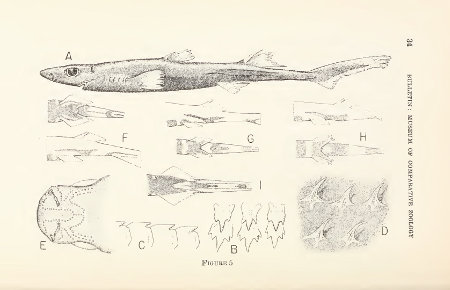
Figure 5 A-D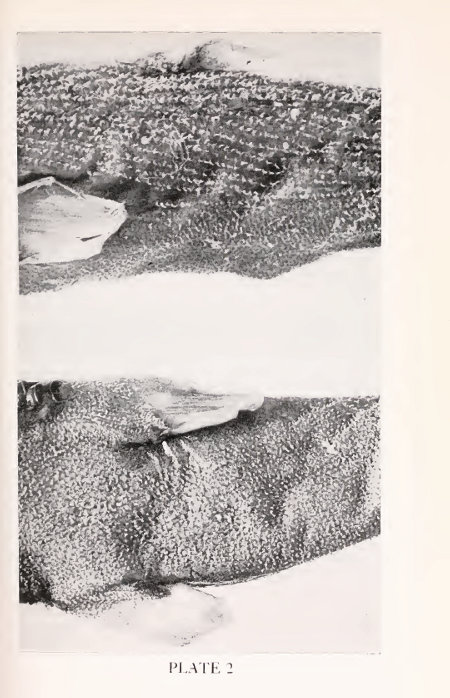
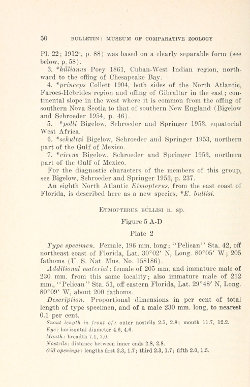 Plate 2. Etmopterus bullisi, new species. Female, 196 mm. long, off
Plate 2. Etmopterus bullisi, new species. Female, 196 mm. long, off
northeast coast of Florida, Pelican sta. 42 (see p. 30). Above, side view
of mid-sector of trunk, x about 3, to show the linear arrangement of the
dermal denticles. Below, ventral view of same, at pectoral fins, to show the
random arrangement of the denticles on the lower surface
Type specimen. Female, 196 mm. long; "Pelican" Sta. 42, off
northeast coast of Florida, Lat. 30°02' N, Long. 80°05' W; 205
fathoms (U. S. Nat. Mus. No. 158186).
Additional material: female of 205 mm. and immature male of
230 mm. from this same locality; also immature male of 212
mm., "Pelican" Sta. 51, off eastern Florida, Lat. 29°48' N, Long.
80°09' W, about 200 fathoms.
Description. Proportional dimensions in per cent of total
length of type specimen, and of a male 230 mm. long, to nearest
0.1 per cent.
Snout length in front of: outer nostrils 2.5, 2.8; mouth 11.7, 12.2.
Eye: horizontal diameter 4.6, 4.6.
Mouth: breadth 7.1, 7.0.
Nostrils: distance between inner ends 2.8, 2.8.
Gill openings: lengths first 2.3, 1.7; third 2.3, 1.7; fifth 2.0, 1.5.
page 51
First dorsal fin: vertical height 3.1, 2.8; length of base 4.6, 4.4.
Second dorsal fin: vertical height 4.6, 4.4; length of base 7.4, 7.0
Caudal fin: upper margin 24.0, 23.5.
Pectoral fin: outer margin 11.0, 10.0; inner margin 4.8, 5.6, width 4.6, 5.2.
Distance from snout to: 1st dorsal 33.7, 33.0; 2nd dorsal 56.6, 57.9;
upper caudal 76.0, 76.5; pectorals 25.0, 24.4; pelvics 51.5, 50.0.
Interspace between: First and second dorsals 18.3, 18.7; 2nd dorsal and
caudal 12.7, 13.9; base of pelvics and caudal 18.9, 20.4.
Teeth: 20/18 27/31
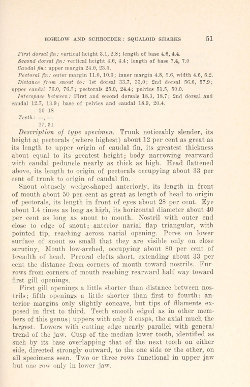 Description of type specimen. Trunk noticeably slender, its
Description of type specimen. Trunk noticeably slender, its
height at pectorals (where highest) about 12 per cent as great as
its length to upper origin of caudal fin, its greatest thickness
about equal to its greatest height ; body narrowing rearward
with caudal peduncle nearly as thick as high. Head flattened
above, its length to origin of pectorals occupying about 33 per
cent of trunk to origin of caudal fin.
Snout obtusely wedge-shaped anteriorly, its length in front
of mouth about 50 per cent as great as length of head to origin
of pectorals, its length in front of eyes about 28 per cent. Eye
about 1.4 times as long as high, its horizontal diameter about 40
per cent as long as snout to mouth. Nostril with outer end
close to edge of snout; anterior narial flap triangular, with
pointed tip, reaching across narial opening. Pores on lower
surface of snout so small that they are visible only on close
scrutiny. Mouth low-arched, occupying about 80 per cent of
breadth of head. Preoral clefts short, extending about 33 per
cent the distance from corners of mouth toward nostrils. Fur-
rows from corners of mouth reaching rearward half way toward
first gill openings.
First gill openings a little shorter than distance between nos-
trils; fifth openings a little shorter than first to fourth ; an-
terior margins only slightly concave, but tips of filaments ex-
posed in first to third. Teeth smooth edged as in other mem-
bers of this genus; uppers with only 3 cusps, the axial much the
largest. Lowers with cutting edge nearly parallel with general
trend of the jaw. Cusp of the median lower tooth, identified as
such by its base overlapping that of the next tooth on either
side, directed strongly outward, to the one side or the other, on
all specimens seen. Two or three rows functional in upper jaw
hut one row only in lower jaw.
page 52
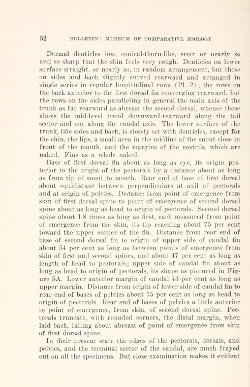 Dermal denticles low, conical-thorn-like, erect or nearly so
Dermal denticles low, conical-thorn-like, erect or nearly so
and so sharp that the skin feels very rough. Denticles on lower
surface straight, or nearly so, in random arrangement, but those
on sides and back slightly curved rearward and arranged in
single series in regular longitudinal rows (PI. 2) ; the rows on
the back anterior to the first dorsal fin converging rearward, but
the rows on the sides paralleling in general the main axis of the
trunk as far rearward as abreast the second dorsal, whence those
above the mid-level trend downward-rearward along the tail
sector and out along the caudal axis. The lower surface of the
trunk, like sides and back, is closely set with denticles, except for
the chin, the lips, a small area in the midline of the snout close in
front of the mouth, and the margins of the nostrils, which are
naked. Fins as a whole naked.
Base of first dorsal fin about as long as eye, its origin pos-
terior to the origin of the pectorals by a distance about as long
as from tip of snout to mouth. Rear end of base of first dorsal
about equidistant between perpendiculars at axil of pectorals
and at origin of pelvics. Distance from point of emergence from
skin of first dorsal spine to point of emergence of second dorsal
spine about as long as head to origin of pectorals. Second dorsal
spine about 1.8 times as long as first, each measured from point
of emergence from the skin, its tip reaching about 75 per cent
toward the upper corner of the fin. Distance from rear end of
base of second dorsal fin to origin of upper side of caudal fin
about 54 per cent as long as between points of emergence from
skin of first and second spines, and about 47 per cent as long as
length of head to pectorals; upper side of caudal fin about as
long as head to origin of pectorals, its shape as pictured in Fig-
ure 5A. Lower anterior margin of caudal 43 per cent as long as
upper margin. Distance from origin of lower side of caudal fin to
rear end of bases of pelvics about 75 per cent as long as head to
origin of pectorals. Rear end of bases of pelvics a little anterior
to point of emergence, from skin, of second dorsal spine. Pec-
torals truncate, with rounded corners, the distal margin, when
laid back, falling about abreast of point of emergence from skin
of first dorsal spine.
In their present state the edges of the pectorals, dorsals, and
pelvics, and the terminal sector of the caudal, are much frayed
out on all the specimens. But close examination makes it evident
page 53
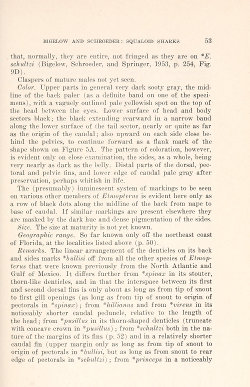 that, normally, they are entire, not fringed as they are on *E.
that, normally, they are entire, not fringed as they are on *E.
schultzi (Bigelow, Schroeder, and Springer, 1953, p. 254, Fig.
9D).
Claspers of mature males not yet seen.
Color. Upper parts in general very dark sooty gray, the mid-
line of the back paler (as a definite band on one of the speci-
mens), with a vaguely outlined pale yellowish spot on the top of
the head between the eyes. Lower surface of head and body
sectors black; the black extending rearward in a narrow band
along the lower surface of the tail sector, nearly or quite as far
as the origin of the caudal ; also upward on each side close be-
hind the pelvics, to continue forward as a flank mark of the
shape shown on Figure 5A. The pattern of coloration, however,
is evident only on close examination, the sides, as a whole, being
very nearly as dark as the belly. Distal parts of the dorsal, pec-
toral and pelvic fins, and lower edge of caudal pale gray after
preservation, perhaps whitish in life
The (presumably) luminescent system of markings to be seen
on various other members of Etmopterus is evident here only as
a row of black dots along the midline of the back from nape to
base of caudal. If similar markings are present elsewhere they
are masked by the dark hue and dense pigmentation of the sides.
Size. The size at maturity is not yet known.
Geographic range. So far known only off the northeast coast
ofFlorida, at the localities listed above (p. 50).
Remarks. The linear arrangement of the denticles on its back
and sides marks *bullisi off from all the other species of Etmop-
terus that were known previously from the North Atlantic and
Gulf of Mexico. It differs further from *spinax in its stouter,
thorn-like denticles, and in that the interspace between its first
and second dorsal fins is only about as long as from tip of snout
to first gill openings (as long as from tip of snout to origin of
pectorals in *spinax) ; from *hillianus and from *virens in its
noticeably shorter caudal peduncle, relative to the length of
the head; from *pusillus in its thorn-shaped denticles (truncate
with concave crown in *pusillus) ; from *schultzi both in the na-
ture of the margins of its fins (p. 52) and in a relatively shorter
caudal fin (upper margin only as long as from tip of snout to
origin of pectorals in *bullisi, but as long as from snout to rear
edge of pectorals in *schultzi) ; from *princeps in a noticeably
page 54
 longer interspace between its second dorsal and the origin of the
longer interspace between its second dorsal and the origin of the
upper side of its caudal (to mention only the most conspicuous
difference) ; and from *polli its tricuspid upper teeth (mostly
with 5 cusps in *polli), in the roughness of the lower side of its
snout, and in the minuteness of the pores there.
Among species known from other seas, it agrees with *lucifer
(originally described from Japan) in the linear arrangement of
the denticles on the sides of the head and body, and in their
thorn-like nature, also with *villosus of Hawaiian waters; with
*brachyurus, originally described from the Philippines (p. 59);
and with *abernathyi, from New Zealand. But there is no dan-
ger of confusing it with either one of these for the following
reasons: the distance from the tip of its snout to its first dorsal
fin spine is shorter relatively than in *villosus but its caudal fin
is considerably longer; the upper margin of its caudal is much
longer relatively than in *brachyurus; the interspace between
its two dorsal fins (not longer than from tip of snout to first gill
openings) is noticeably shorter than in either *lucifer or *aber-
nathyi (at least as long as from tip of snout to origin of pec-
torals), and its flank marks are much less conspicuous (cf. Fig.
5 A with Fig. 6A) than in either of these last two.
The Mediterranean shark, also, that was named Squalus in-
fernus by Blainville (1825, p. 59), a century and a quarter ago,
is referable to Etmopterus by Blainville 's account of its upper
teeth as three-cusped, but of its lowers as one-cusped, with hori-
zontal cutting edge.10 And there is nothing in the dimensions
given for it by Blainville to set it apart from *E. spinax, as ap-
pears from the accompanying comparative table. Our earlier
statement (Bigelow, Schroeder and Springer 1953, p. 224) that
its proportional dimensions differ from those of other Atlantic
species was based on a misreading of the measurements given for
it by Blainville.
Proportional dimensions in per cent of total length (A)
for the type specimen, 255 mm. ("dix pouces") long, of
infernus Blainville 1825; and (B) for a female *spinax,
about 285 mm. long, from the Mediterranean, in the Mu-
seum of Comparative Zoology.
________________________________________________
10 Notwithstanding its tooth characters, Garman (1913, p. 197) classed it as a
synonym of *Centrophorus uyato Rafinesque 1810. We may also point out that
Blainville's (1825, p. 59) reference for it to his "PI. 14, Fig. 2" was incorrect;
actually this figure represents a *Lamna nasus.
page 55
|
|
A |
B |
|
Snout to 5th gill openings |
19 |
21 |
|
Snout to cloaca |
57 |
58 |
|
Snout to 1st darsal fin |
31 |
32 |
|
Snout to 2nd dorsal fin |
63 |
63 |
|
Cloaca to lower origin of caudal fin |
23 |
19 |
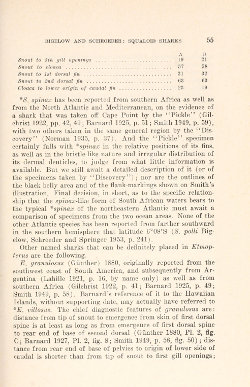 *S. spinax has been reported from southern Africa as well as
*S. spinax has been reported from southern Africa as well as
from the North Atlantic and Mediterranean, on the evidence of
a shark that was taken off Cape Point by the "Pickle" (Gil-
christ 1922, pp. 42, 49; Barnard 1925, p. 51; Smith 1949, p. 59),
with two others taken in the same general region by the "Dis-
covery" (Norman 1935, p. 37). And the "Pickle" specimen
certainly falls with *spinax in the relative positions of its fins,
as well as in the bristle-like nature and irregular distribution of
its dermal denticles, to judge from what little information is
available. But we still await a detailed description of it (or of
the specimens taken by "Discovery"); nor are the outlines of
the black belly area and of the flank-markings shown on Smith's
illustration. Final decision, in short, as to the specific relation-
ship that the spinax-like form of South African waters bears to
the typical *spinax of the northeastern Atlantic must await a
comparison of specimens from the two ocean areas. None of the
other Atlantic species has been reported from farther southward
in the southern hemisphere that latitude 6°08'S (S. polli Big-
elow, Schroeder and Springer 1953, p. 241).
Other named sharks that can be definitely placed in Etmop-
terus are the following.
E. granulosus (Günther) 1880, originally reported from the
southwest coast of South America, and subsequently from Ar-
gentina (Lahille 1921, p. 16, by name only) as well as from
southern Africa (Gilchrist 1922, p. 41; Barnard 1925, p. 49;
Smith 1949, p. 58). Barnard's reference of it to the Hawaiian
Islands, without supporting date, may actually have referred to
*E. villosus. The chief diagnostic features of granulosus are:
distance from tip of snout to emergence from skin of first dorsal
spine is at least as long as from emergence of first dorsal spine
to rear end of base of second dorsal (Günther 1880, PL 2, fig.
C; Barnard 1927, PI. 2, fig. 8; Smith 1949, p. 58, fig. 50) ; dis-
tance from rear end of base of pelvics to origin of lower side of
caudal is shorter than from tip of snout to first gill openings;
page 56
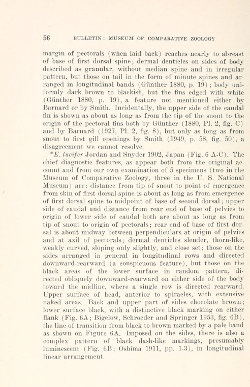 margin of pectorals (when laid back) reaches nearly to abreast
margin of pectorals (when laid back) reaches nearly to abreast
of base of first dorsal spine; dermal denticles on sides of body-
described as granular, without median spine and in irregular
pattern, but those on tail in the form of minute spines and ar-
ranged in longitudinal bands (Günther 1880, p. 19) ; body uni-
formly dark brown to blackish, but the fins edged with white
(Günther 1880, p. 19), a feature not mentioned either by
Barnard or by Smith. Incidentally, the upper side of the caudal
fin is shown as about as long as from the tip of the snout to the
origin of the pectoral fins both by Günther (1880, PI. 2, fig. C)
and by Barnard (1927, PI. 2, fig. 8), but only as long as from
snout to first gill openings by Smith (1949, p. 58, fig. 50), a
disagreement we cannot resolve.
*E. lucifer Jordan and Snyder 1902, Japan (Fig. 6 A-C). The
chief diagnostic features, as appear both from the original ac-
count and from our own examination of 5 specimens (two in the
Museum of Comparative Zoology, three in the U. S. National
Museum) are: distance from tip of snout to point of emergence
from skin of first dorsal spine is about as long as from emergence
of first dorsal spine to midpoint of base of second dorsal ; upper
side of caudal and distance from rear end of base of pelvics to
origin of lower side of caudal both are about as long as from
tip of snout to origin of pectorals; rear end of base of first dor-
sal is about midway between perpendiculars at origin of pelvics
and at axil of pectorals ; dermal denticles slender, thorn-like,
weakly curved, sloping only slightly, and close set; those on the
sides arranged in general in longitudinal rows and directed
downward-rearward (a conspicuous feature), but those on the
black areas of the lower surface in random pattern, di-
rected obliquely downward-rearward on either side of the body
toward the midline, where a single row is directed rearward.
Upper surface of head, anterior to spiracles, with extensive
naked areas. Back and upper part of sides chocolate brown;
lower surface black, with a distinctive black marking on either
flank (Fig. 6A; Bigelow, Schroeder and Springer 1953, fig. 6B),
the line of transition from black to brown marked by a pale band
as shown on Figure 6 A. Imposed on the sides, there is also a
complex pattern of black dash-like markings, presumably
luminescent (Fig. 6B ; Oshima 1911, pp. 1-3), in longitudinal
linear arrangement.
page 57
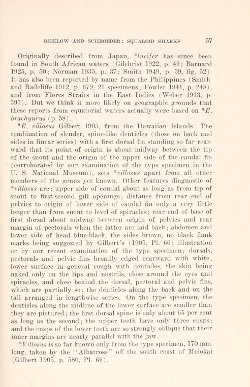 Originally described from Japan, *lucifer has since been
Originally described from Japan, *lucifer has since been
found in South African waters (Gilchrist 1922, p. 49; Barnard
1925, p. 50; Norman 1935, p. 37; Smith 1949, p. 59, fig. 52).
It has also been reported by name from the Philippines (Smith
and Radcliffe 1912, p. 679, 21 specimens; Fowler 1941, p. 248),
and from Flores Straits in the East Indies (Weber 1913, p.
597). But we think it more likely on geographic grounds that
these reports from equatorial waters actually were based on *E.
brachyurus (p. 58).
*E. villosus Gilbert 1905, from the Hawaiian Islands. The
combination of slender, spine-like denticles (those on back and
sides in linear series) with a first dorsal fin standing so far rear-
ward that its point of origin is about midway between the tip
of the snout and the origin of the upper side of the caudal fin
(corroborated by our examination of the type specimen in the
U. S. National Museum), sets *villosus apart from all other
members of the genus yet known. Other features diagnostic of
*villosus are : upper side of caudal about as long as from tip of
snout to first-second gill openings; distance from rear end of
pelvics to origin of lower side of caudal fin only a very little
longer than from snout to level of spiracles; rear end of base of
first dorsal about midway between origin of pelvics and rear
margin of pectorals when the latter are laid back ; abdomen and
lower side of head blue-black, the sides brown, no black flank
marks being suggested by Gilbert's (1905, PI. 66) illustration
or by our recent examination of the type specimen; dorsals,
pectorals and pelvic fins broadly edged rearward with white ;
lower surface in general rough with denticles, the skin being
naked only on the lips and nostrils, close around the eyes and
spiracles, and close behind the dorsal, pectoral and pelvic fins,
which are partially so; the denticles along the back and on the
tail arranged in lengthwise series. On the type specimen, the
denticles along the midline of the lower surface are smaller than
they are pictured; the first dorsal spine is only about 65 per cent
as long as the second; the upper teeth have only three cusps;
and the cusps of the lower teeth are so strongly oblique that their
inner margins are nearly parallel with the jaw.
*Villosus is so far known only from the type specimen, 170 mm.
long, taken by the "Albatross" off the south coast of Molokai
(Gilbert 1905, p. 580, PI. 66).
page 58
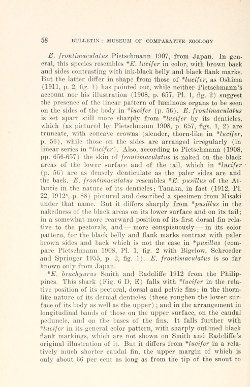 E. frontimaculatus Pietschmann 1907, from Japan. In gen-
E. frontimaculatus Pietschmann 1907, from Japan. In gen-
eral, this species resembles *E. lucifer in color, with brown back
and sides contrasting with ink-black belly and black flank marks.
But the latter differ in shape from those of *lucifer, as Oshima
(1911, p. 2, fig. 1) has pointed out, while neither Pietschmann 's
account nor his illustration (1908, p. 657, PI. 1, fig. 2) suggest
the presence of the linear pattern of luminous organs to be seen
on the sides of the body in *lucifer (p. 56). E. frontimaculatus
is set apart still more sharply from *lucifer by its denticles,
which (as pictured by Pietschmann 1908, p. 657, figs. 1, 2) are
truncate, with concave crowns (slender, thorn-like in *lucifer,
p. 56), while those on the sides are arranged irregularly (in
linear series in *lucifer). Also, according to Pietschmann (1908,
pp. 656-657) the skin of frontimaculatus is naked on the black
areas of the lower surface and of the tail, which in *lucifer
(p. 56) are as densely denticulate as the paler sides are and
the back. E. frontimaculatus resembles *E. pusillus of the At-
lantic in the nature of its denticles; Tanaka, in fact (1912, PI.
22, 1912a, p. 88) pictured and described a specimen from Misaki
under that name. But it differs sharply from *pusillus in the
nakedness of the black areas on its lower surface and on its tail ;
in a somewhat more rearward position of its first dorsal fin rela-
tive to the pectorals, and -more conspicuously- in its color
pattern, for the black belly and flank marks contrast with paler
brown sides and back which is not the case in *pusillus (com-
pare Pietschmann 1908, PI. 1, fig. 2 with Bigelow, Schroeder
and Springer 1955, p. 3, fig. 1). E. frontimaculatus is so far
known only fromJapan.
*E. brachyurus Smith and Radcliffe 1912 from the Philip-
pines. This shark (Fig. 6 D, E) falls with *lucifer in the rela-
tive position of its pectoral, dorsal and pelvic fins; in the thorn-
like nature of its dermal denticles (these roughen the lower sur-
face of its body as well as the upper) ; and in the arrangement in
longitudinal bauds of those on the upper surface, on the caudal
peduncle, and on the bases of the fins. It falls further with
*lucifer in its general color pattern, with sharply outlined black
flank markings, which are not shown on Smith and Radcliffe's
original illustration of it. But it differs from *lucifer in a rela-
tively much shorter caudal fin, the upper margin of which is
only about 66 per cent as long as from the tip of the snout to
page 59
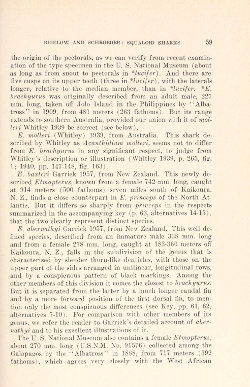 the origin of the pectorals, as we can verify from recent examin-
the origin of the pectorals, as we can verify from recent examin-
ation of the type specimen in the U. S. National Museum (about
as long as from snout to pectorals in *lucifer). And there are
five cusps on its upper teeth (three in *lucifer), with the laterals
longer, relative to the median member, than in *lucifer. *E.
brachyurus was originally described from an adult male, 227
mm. long, taken off Jolo Island in the Philippines by "Alba-
tross" in 1909, from 481 meters (263 fathoms). But its range
extends to southern Australia, provided our union with it of mol-
leri Whitley 1939 be correct (see below).
E. molleri (Whitley) 1939, from Australia. This shark de-
scribed by Whitley as Acanthidium molleri, seems not to differ
from E. brachyurus in any significant respect, to judge from
Whitley's description or illustration (Whitley 1939, p. 265, fig.
1; 1940, pp. 147-148, fig. 163).
E. baxteri Garrick 1957, from New Zealand. This newly de-
scribed Etmopterus, known from a female 742 mm. long, caught
at 914 meters (500 fathoms) seven miles south of Kaikoura,
N. Z., finds a close counterpart in E. princeps of the North At-
lantic. But it differs so sharply from princeps in the respects
summarized in the accompanying key (p. 63, alternatives 14-15),
that the two clearly represent distinct species.
E. abernathyi Clarrick 1957, from New Zealand. This well de-
fined species, described from an immature male 338 mm. long
and from a female 278 mm. long, caught at 183-366 meters off'
Kaikoura, N. Z., falls in the subdivision of the genus that is
characterized by slender thorn-like denticles, with those on the
upper part of the sides arranged in unilinear, longitudinal rows,
and by a conspicuous pattern of black markings. Among the
other members of this division it comes the closest to brachyurus.
But it is separated from the latter by a much longer caudal fin
and by a more forward position of the first dorsal fin, to men-
tion only the most conspicuous differences (see Key, pp. 61, 62,
alternatives 7-10). For comparison with other members of its
genus, we refer the reader to Garrick's detailed account of aber-
nathyi and to his excellent illustrations of it.
The U. S. National Museum also contains a female Etmopterus,
about 270 mm. long (U.S.N.M. No. 91576) collected among the
Galapagos by the "'Albatross" in 1888, from 717 meters (392
fathoms), which agrees very closely with the West African
page 60
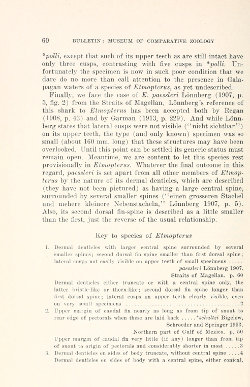 *polli, except that such of its upper teeth as are still intact have
*polli, except that such of its upper teeth as are still intact have
only three cusps, contrasting with five cusps in *polli. Un-
fortunately the specimen is now in such poor condition that we
dare do no more than call attention to the presence in Gala-
pagan waters of a species of Etmopterus, as yet undescribed.
Finally, we face the case of E. paessleri Lönnberg (1907, p.
5, fig. 2) from the Straits of Magellan. Lönnberg's reference of
this shark to Etmopterus has been accepted both by Regan
(1908, p. 43) and by Garman (1913, p. 229). And while Lönn-
berg states that lateral cusps were not visible ("nicht sichtbar")
on its upper teeth, the type (and only known) specimen was so
small (about 160 mm. long) that these structures may have been
overlooked. Until this point can be settled its generic status must
remain open. Meantime, we are content to let this species rest
provisionally in Etmopterus. Whatever the final outcome in this
regard, paessleri is set apart from all other members of Etmop-
terus by the nature of its dermal denticles, which are described
(they have not been pictured) as having a large central spine,
surrounded by several smaller spines ("einen grosseren Stachel
und mehere kleinere Nebenstacheln, " Lönnberg 1907, p. 5).
Also, its second dorsal fin-spine is described as a little smaller
than the first, just the reverse of the usual relationship.
















